Running Windows XP - (Doc)
25 Pages5916 Words39 Views
Added on 2020-01-23
Running Windows XP - (Doc)
Added on 2020-01-23
ShareRelated Documents
Task A1:
Numerous associations keep on running Windows XP on numerous or the greater part of their
desktop PCs, either on the grounds that relocation commonly requires expensive equipment
updates, tedious exchanges of settings, and client retraining, or on the grounds that there's
basically no convincing motivation to move clients to another OS and the new application
programming that accompanies it. At times, both supports apply. In any case, when you consider
that Microsoft has effectively quit issuing non-security hotfixes for Windows XP and will end all
support for the OS in 2014, that system won't be legitimate for any longer.
Virtual desktop base (VDI) uses server equipment to run desktop working frameworks and
application programming inside a virtual machine. Clients get to these virtual desktops utilizing
their current PCs. This not just disposes of the requirement for workstation equipment redesigns,
additionally empowers the client to switch between working situations, for example, Windows
XP and Windows 7.
Besides, renders regulatory and administration assignments much less demanding, in light of the
fact that each connected workstation can utilize similar picture. Introduce OS and application
programming upgrades and fixes to the one picture, and each desktop framework utilizing that
picture is consequently redesigned and fixed. VDI offers clear advantages, however there are two
sides to each coin. Here's a brief take a gander at the advantages and disadvantages of utilizing
virtual desktop framework:
Each desktop client can use similar picture.
Star: Having every client use similar picture - the working framework and the introduced
applications decreases managerial and bolster costs.
Numerous associations keep on running Windows XP on numerous or the greater part of their
desktop PCs, either on the grounds that relocation commonly requires expensive equipment
updates, tedious exchanges of settings, and client retraining, or on the grounds that there's
basically no convincing motivation to move clients to another OS and the new application
programming that accompanies it. At times, both supports apply. In any case, when you consider
that Microsoft has effectively quit issuing non-security hotfixes for Windows XP and will end all
support for the OS in 2014, that system won't be legitimate for any longer.
Virtual desktop base (VDI) uses server equipment to run desktop working frameworks and
application programming inside a virtual machine. Clients get to these virtual desktops utilizing
their current PCs. This not just disposes of the requirement for workstation equipment redesigns,
additionally empowers the client to switch between working situations, for example, Windows
XP and Windows 7.
Besides, renders regulatory and administration assignments much less demanding, in light of the
fact that each connected workstation can utilize similar picture. Introduce OS and application
programming upgrades and fixes to the one picture, and each desktop framework utilizing that
picture is consequently redesigned and fixed. VDI offers clear advantages, however there are two
sides to each coin. Here's a brief take a gander at the advantages and disadvantages of utilizing
virtual desktop framework:
Each desktop client can use similar picture.
Star: Having every client use similar picture - the working framework and the introduced
applications decreases managerial and bolster costs.
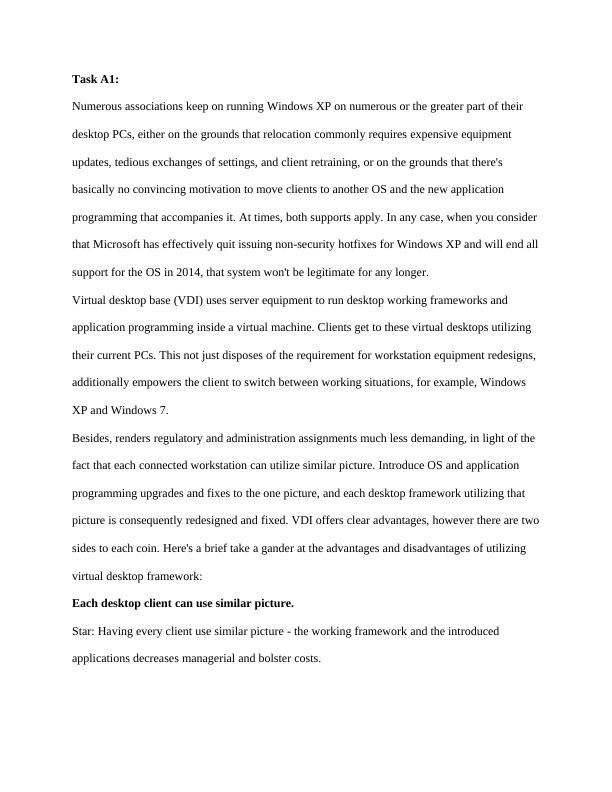
Con: You'll require a novel picture for every client who requires an alternate arrangement of
uses, needs to spare individual settings, or requires the opportunity to introduce their own
applications. This will quickly increase stockpiling utilization on the VDI server.
Handling moves from individual workstations to a VDI server.
Genius: There's no compelling reason to overhaul various PCs to meet the new OS's base
equipment necessities.
Con: VDI will require a noteworthy interest in server equipment, and potentially away and
organize foundation. The aggregate cost of the server equipment, stockpiling, and system gear
may surpass that of acquiring a fundamental PC for every client.
Equipment expenses can be all the more effectively overseen, since nearly everything will
live in the server farm.
Master: Instead of purchasing a pile of PCs that will be scattered around the workplace - or even
outside the workplace in case you're supporting a versatile workforce or representatives who
work remotely- - you'll gain one premium framework with repetitive power supplies, an UPS,
superior stockpiling, and high-data transfer capacity organizing that will convey skilled
equipment to all clients similarly.
Con: Procuring one major server implies an expansive introductory expense, versus economical
PCs that can be obtained in stages or overhauled a couple at once. In the event that that one
server goes down, each client depending on that machine will be not able work. On the off
chance that a solitary PC goes down, stand out client is affected.
Keeping up a solitary OS picture can lessen administration and bolster costs.
Master: Install applications, patches, and drivers once, and each client depending on that picture
profits by the overhaul.
uses, needs to spare individual settings, or requires the opportunity to introduce their own
applications. This will quickly increase stockpiling utilization on the VDI server.
Handling moves from individual workstations to a VDI server.
Genius: There's no compelling reason to overhaul various PCs to meet the new OS's base
equipment necessities.
Con: VDI will require a noteworthy interest in server equipment, and potentially away and
organize foundation. The aggregate cost of the server equipment, stockpiling, and system gear
may surpass that of acquiring a fundamental PC for every client.
Equipment expenses can be all the more effectively overseen, since nearly everything will
live in the server farm.
Master: Instead of purchasing a pile of PCs that will be scattered around the workplace - or even
outside the workplace in case you're supporting a versatile workforce or representatives who
work remotely- - you'll gain one premium framework with repetitive power supplies, an UPS,
superior stockpiling, and high-data transfer capacity organizing that will convey skilled
equipment to all clients similarly.
Con: Procuring one major server implies an expansive introductory expense, versus economical
PCs that can be obtained in stages or overhauled a couple at once. In the event that that one
server goes down, each client depending on that machine will be not able work. On the off
chance that a solitary PC goes down, stand out client is affected.
Keeping up a solitary OS picture can lessen administration and bolster costs.
Master: Install applications, patches, and drivers once, and each client depending on that picture
profits by the overhaul.
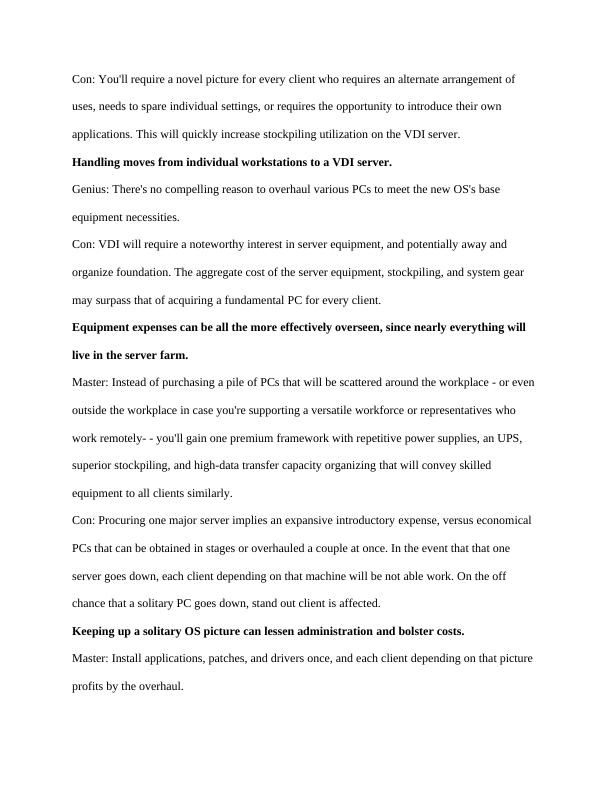
Con: Administrators should take in the VDI programming's capacities and restrictions. Obliging
clients who require novel applications or their own personalization settings can bring about
picture multiplication, which can wind up being more hard to oversee than working separate
workstations.
When you experience issues, you'll for the most part have only one framework to
investigate.
Star: Problems can by and large be determined from inside the server farm; there's no compelling
reason to head out to the real PCs. Since pictures can normally be gotten to from any associated
workstation, a client encountering equipment inconvenience on their standard PC can basically
go to another workstation and get to their information and applications.
Con: Server-side issues can influence numerous clients - everybody utilizing that server or that
picture. Consequently, it's a smart thought to set up repetitive servers as a safeguard.
clients who require novel applications or their own personalization settings can bring about
picture multiplication, which can wind up being more hard to oversee than working separate
workstations.
When you experience issues, you'll for the most part have only one framework to
investigate.
Star: Problems can by and large be determined from inside the server farm; there's no compelling
reason to head out to the real PCs. Since pictures can normally be gotten to from any associated
workstation, a client encountering equipment inconvenience on their standard PC can basically
go to another workstation and get to their information and applications.
Con: Server-side issues can influence numerous clients - everybody utilizing that server or that
picture. Consequently, it's a smart thought to set up repetitive servers as a safeguard.
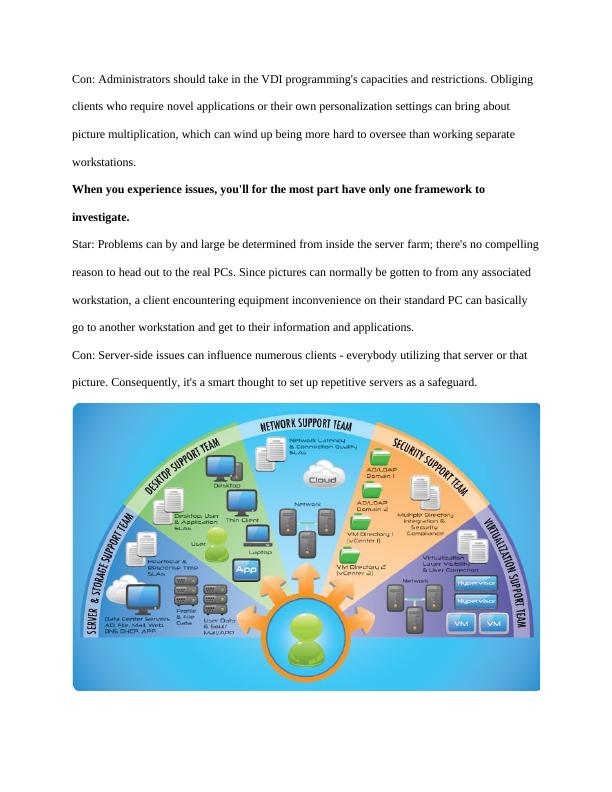
Task A2:
PCs and different gadgets on a Wi-Fi must share a limited limit of assets. As far as possible for
what number of gadgets can interface with and utilize a remote system rely on upon different
variables.
What number of Access Points?
Most home systems and open Wi-Fi hotspots work with a solitary remote get to point (a
broadband switch on account of home systems administration). Then again, bigger business PC
systems introduce different get to focuses to extend the remote system's scope to a much bigger
physical zone. Every get to point has limits for the quantity of associations and measure of
system load it can deal with, yet by incorporating numerous of them into a bigger system, the
general scale can be expanded.
Hypothetical Limits of Wi-Fi Network Scaling
Numerous individual remote switches and different get to focuses bolster up to roughly 250
associated gadgets. Switches can empower a little number (for the most part somewhere around
one and four) of wired Ethernet customers with the rest associated through Wi-Fi joins.
The speed rating of get to focuses speaks to the most extreme hypothetical system data transfer
capacity they can bolster. Wi-Fi switches appraised at 300 Mbps with 100 gadgets associated, for
instance, can just offer by and large 3 Mbps to each of them. Actually, most customers just
utilize their system association sometimes, and a switch moves its accessible data transmission to
the customers that need it.
Down to earth Limits of Wi-Fi Network Scaling
Interfacing 250 gadgets to a solitary Wi-Fi get to point, while hypothetically conceivable, is not
possible by and by for a couple reasons:
PCs and different gadgets on a Wi-Fi must share a limited limit of assets. As far as possible for
what number of gadgets can interface with and utilize a remote system rely on upon different
variables.
What number of Access Points?
Most home systems and open Wi-Fi hotspots work with a solitary remote get to point (a
broadband switch on account of home systems administration). Then again, bigger business PC
systems introduce different get to focuses to extend the remote system's scope to a much bigger
physical zone. Every get to point has limits for the quantity of associations and measure of
system load it can deal with, yet by incorporating numerous of them into a bigger system, the
general scale can be expanded.
Hypothetical Limits of Wi-Fi Network Scaling
Numerous individual remote switches and different get to focuses bolster up to roughly 250
associated gadgets. Switches can empower a little number (for the most part somewhere around
one and four) of wired Ethernet customers with the rest associated through Wi-Fi joins.
The speed rating of get to focuses speaks to the most extreme hypothetical system data transfer
capacity they can bolster. Wi-Fi switches appraised at 300 Mbps with 100 gadgets associated, for
instance, can just offer by and large 3 Mbps to each of them. Actually, most customers just
utilize their system association sometimes, and a switch moves its accessible data transmission to
the customers that need it.
Down to earth Limits of Wi-Fi Network Scaling
Interfacing 250 gadgets to a solitary Wi-Fi get to point, while hypothetically conceivable, is not
possible by and by for a couple reasons:

On home systems, all gadgets regularly share a solitary Internet association. The execution of
customers' Internet get to will begin to debase as more gadgets join the system and begin
utilizing it at the same time. Indeed, even only a modest bunch of dynamic gadgets doing video
gushing or substantial Web downloading can rapidly maximize a mutual Internet connect. Get to
focuses overheat (and quit working) when working at outrageous burdens for expanded periods,
regardless of the possibility that taking care of just nearby movement and not getting to the
Internet.
Having extensive number of Wi-Fi customers gathered in close physical closeness like a home or
office building produces critical remote flag obstruction. Radio obstruction among Wi-Fi
customers debases arranges execution (because of successive re-broadcasting of messages that
neglect to achieve their goal) and in the end causes association drops.
Some home switches incorporate an element that permits directors to control the quantity of
customers that can at the same time interface. Numerous Linksys switches, for instance, set a
default most extreme of 50 greatest customers. Brilliant overseers regularly keep a farthest point
like this set up to keep the switch and system running dependably. Introducing a second switch
or get to point on a home system can significantly convey the system stack. By adding more get
to focuses to the system, adequately any number of gadgets can be upheld (however the system
turns out to be dynamically harder to oversee).
customers' Internet get to will begin to debase as more gadgets join the system and begin
utilizing it at the same time. Indeed, even only a modest bunch of dynamic gadgets doing video
gushing or substantial Web downloading can rapidly maximize a mutual Internet connect. Get to
focuses overheat (and quit working) when working at outrageous burdens for expanded periods,
regardless of the possibility that taking care of just nearby movement and not getting to the
Internet.
Having extensive number of Wi-Fi customers gathered in close physical closeness like a home or
office building produces critical remote flag obstruction. Radio obstruction among Wi-Fi
customers debases arranges execution (because of successive re-broadcasting of messages that
neglect to achieve their goal) and in the end causes association drops.
Some home switches incorporate an element that permits directors to control the quantity of
customers that can at the same time interface. Numerous Linksys switches, for instance, set a
default most extreme of 50 greatest customers. Brilliant overseers regularly keep a farthest point
like this set up to keep the switch and system running dependably. Introducing a second switch
or get to point on a home system can significantly convey the system stack. By adding more get
to focuses to the system, adequately any number of gadgets can be upheld (however the system
turns out to be dynamically harder to oversee).
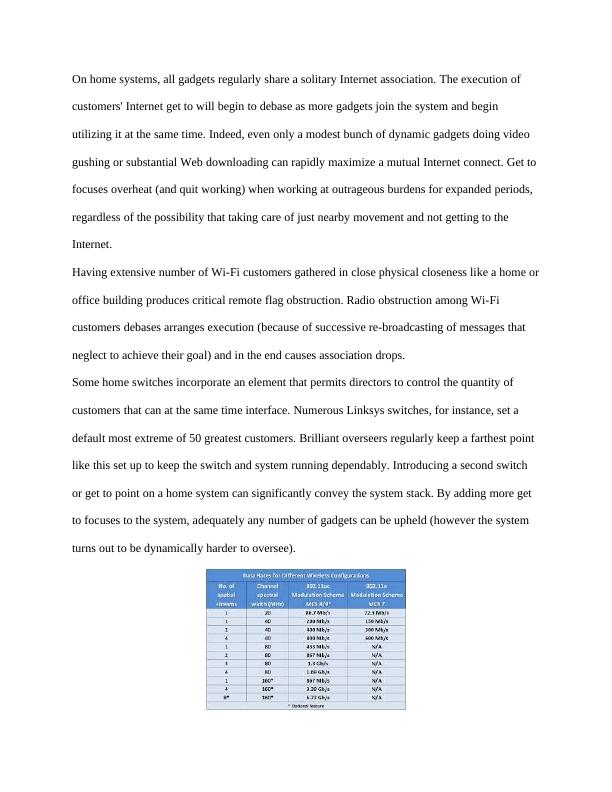
Task A3:
Understanding IP sub-netting is a major prerequisite for any geek - whether you're a coder, a
database director or the CTO. Be that as it may, as basic as the ideas seem to be, there is a
general trouble in comprehension the theme.
Here we'll break this subject into eight basic strides and help you set up the pieces together to
completely comprehend IP subnetting.
These means will give you the fundamental data required with a specific end goal to design
switches or see how IP locations are separated and how subnetting functions. You'll likewise
figure out how to arrange a fundamental home or little office organize.
A fundamental comprehension of how twofold and decimal numbers function is required. What's
more, these definitions and terms will kick you off:
IP Address: A coherent numeric delivers that is doled out to each and every PC, printer, switch,
switch or whatever other gadget that is a piece of a TCP/IP-based system
Subnet: A different and identifiable partition of an association's system, regularly organized on
one story, building or topographical area
Subnet Mask: A 32-bit number used to separate the system segment of an IP address by
partitioning the IP address into a system address and host address
Organize Interface Card (NIC): A PC equipment part that permits a PC to associate with a
system.
To comprehend why we require subnets (short for subnetwork), how about we begin right from
the earliest starting point and perceive that we have to converse with "things" on systems. Clients
need to converse with printers, email programs need to converse with servers, and each of these
"things" needs some kind of address. This is the same as a house address, however with one
Understanding IP sub-netting is a major prerequisite for any geek - whether you're a coder, a
database director or the CTO. Be that as it may, as basic as the ideas seem to be, there is a
general trouble in comprehension the theme.
Here we'll break this subject into eight basic strides and help you set up the pieces together to
completely comprehend IP subnetting.
These means will give you the fundamental data required with a specific end goal to design
switches or see how IP locations are separated and how subnetting functions. You'll likewise
figure out how to arrange a fundamental home or little office organize.
A fundamental comprehension of how twofold and decimal numbers function is required. What's
more, these definitions and terms will kick you off:
IP Address: A coherent numeric delivers that is doled out to each and every PC, printer, switch,
switch or whatever other gadget that is a piece of a TCP/IP-based system
Subnet: A different and identifiable partition of an association's system, regularly organized on
one story, building or topographical area
Subnet Mask: A 32-bit number used to separate the system segment of an IP address by
partitioning the IP address into a system address and host address
Organize Interface Card (NIC): A PC equipment part that permits a PC to associate with a
system.
To comprehend why we require subnets (short for subnetwork), how about we begin right from
the earliest starting point and perceive that we have to converse with "things" on systems. Clients
need to converse with printers, email programs need to converse with servers, and each of these
"things" needs some kind of address. This is the same as a house address, however with one
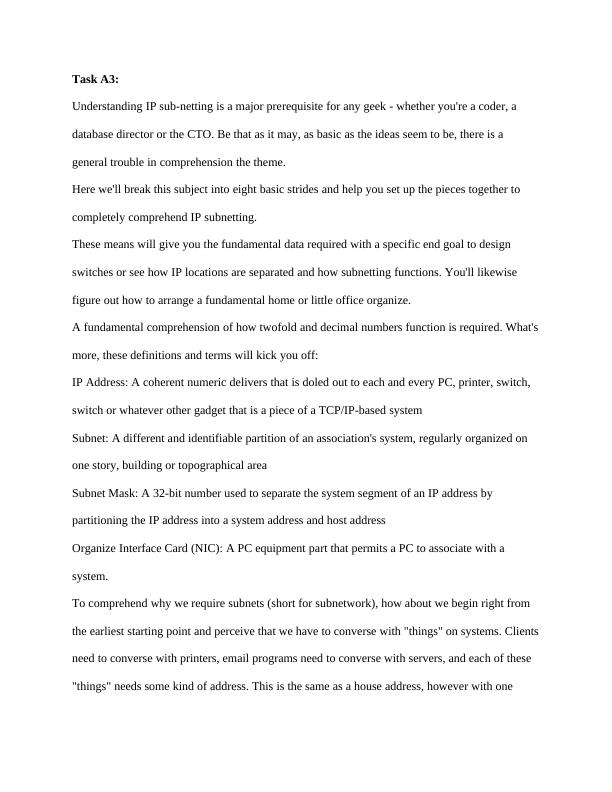
End of preview
Want to access all the pages? Upload your documents or become a member.
Related Documents
Desktop Virtualization- Doclg...
|16
|5077
|233
Desklib - Online Library for Study Material with Solved Assignments, Essays, Dissertationslg...
|20
|3043
|495
